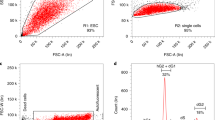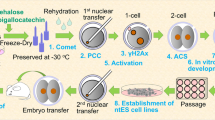Abstract
Since the creation of Dolly via somatic cell nuclear transfer (SCNT)1, more than a dozen species of mammals have been cloned using this technology2. One hypothesis for the limited success of cloning via SCNT (1%–5%)3 is that the clones are likely to be derived from adult stem cells4. Support for this hypothesis comes from the findings that the reproductive cloning efficiency for embryonic stem cells is five to ten times higher than that for somatic cells as donors5,6 and that cloned pups cannot be produced directly from cloned embryos derived from differentiated B and T cells or neuronal cells7,8,9,10. The question remains as to whether SCNT-derived animal clones can be derived from truly differentiated somatic cells. We tested this hypothesis with mouse hematopoietic cells at different differentiation stages: hematopoietic stem cells, progenitor cells and granulocytes. We found that cloning efficiency increases over the differentiation hierarchy, and terminally differentiated postmitotic granulocytes yield cloned pups with the greatest cloning efficiency.
This is a preview of subscription content, access via your institution
Access options
Subscribe to this journal
Receive 12 print issues and online access
$209.00 per year
only $17.42 per issue
Buy this article
- Purchase on Springer Link
- Instant access to full article PDF
Prices may be subject to local taxes which are calculated during checkout




Similar content being viewed by others
Accession codes
References
Wilmut, I., Schnieke, A.E., McWhir, J., Kind, A.J. & Campbell, K.H. Viable offspring derived from fetal and adult mammalian cells. Nature 385, 810–813 (1997).
Tian, X.C., Kubota, C., Enright, B. & Yang, X. Cloning animals by somatic cell nuclear transfer–biological factors. Reprod. Biol. Endocrinol. 1, 98 (2003).
Yanagimachi, R. Cloning: experience from the mouse and other animals. Mol. Cell. Endocrinol. 187, 241–248 (2002).
Hochedlinger, K. & Jaenisch, R. Nuclear transplantation: lessons from frogs and mice. Curr. Opin. Cell Biol. 14, 741–748 (2002).
Rideout, W.M., III, Eggan, K. & Jaenisch, R. Nuclear cloning and epigenetic reprogramming of the genome. Science 293, 1093–1098 (2001).
Humpherys, D. et al. Epigenetic instability in ES cells and cloned mice. Science 293, 95–97 (2001).
Eggan, K. et al. Hybrid vigor, fetal overgrowth, and viability of mice derived by nuclear cloning and tetraploid embryo complementation. Proc. Natl. Acad. Sci. USA 98, 6209–6214 (2001).
Eggan, K. et al. Mice cloned from olfactory sensory neurons. Nature 428, 44–49 (2004).
Li, J., Ishii, T., Feinstein, P. & Mombaerts, P. Odorant receptor gene choice is reset by nuclear transfer from mouse olfactory sensory neurons. Nature 428, 393–399 (2004).
Hochedlinger, K. & Jaenisch, R. Monoclonal mice generated by nuclear transfer from mature B and T donor cells. Nature 415, 1035–1038 (2002).
Weissman, I.L., Anderson, D.J. & Gage, F. Stem and progenitor cells: origins, phenotypes, lineage commitments, and transdifferentiations. Annu. Rev. Cell Dev. Biol. 17, 387–403 (2001).
Yu, H., Yuan, Y., Shen, H. & Cheng, T. Hematopoietic stem cell exhaustion impacted by p18 INK4C and p21 Cip1/Waf1 in opposite manners. Blood 107, 1200–1206 (2006).
Yuan, Y., Shen, H., Franklin, D.S., Scadden, D.T. & Cheng, T. In vivo self-renewing divisions of haematopoietic stem cells are increased in the absence of the early G1-phase inhibitor, p18INK4C. Nat. Cell Biol. 6, 436–442 (2004).
Smith, A.L., Ellison, F.M., McCoy, J.P., Jr. & Chen, J. c-Kit expression and stem cell factor-induced hematopoietic cell proliferation are up-regulated in aged B6D2F1 mice. J. Gerontol. A Biol. Sci. Med. Sci. 60, 448–456 (2005).
Wakayama, T., Perry, A.C., Zuccotti, M., Johnson, K.R. & Yanagimachi, R. Full-term development of mice from enucleated oocytes injected with cumulus cell nuclei. Nature 394, 369–374 (1998).
Osawa, M., Hanada, K., Hamada, H. & Nakauchi, H. Long-term lymphohematopoietic reconstitution by a single CD34-low/negative hematopoietic stem cell. Science 273, 242–245 (1996).
Inoue, K. et al. Inefficient reprogramming of the hematopoietic stem cell genome following nuclear transfer. J. Cell Sci. 119, 1985–1991 (2006).
Gao, S., McGarry, M., Latham, K.E. & Wilmut, I. Cloning of mice by nuclear transfer. Cloning Stem Cells 5, 287–294 (2003).
Gao, S. et al. Effect of cell confluence on production of cloned mice using an inbred embryonic stem cell line. Biol. Reprod. 68, 595–603 (2003).
Takano, H., Ema, H., Sudo, K. & Nakauchi, H. Asymmetric division and lineage commitment at the level of hematopoietic stem cells: inference from differentiation in daughter cell and granddaughter cell pairs. J. Exp. Med. 199, 295–302 (2004).
Ramalho-Santos, M., Yoon, S., Matsuzaki, Y., Mulligan, R.C. & Melton, D.A. “Stemness”: transcriptional profiling of embryonic and adult stem cells. Science 298, 597–600 (2002).
Li, J., Ishii, T., Wen, D. & Mombaerts, P. Non-equivalence of cloned and clonal mice. Curr. Biol. 15, R756–R757 (2005).
Inoue, K. et al. Generation of cloned mice by direct nuclear transfer from natural killer T cells. Curr. Biol. 15, 1114–1118 (2005).
Smyth, M.J. et al. Sequential activation of NKT cells and NK cells provides effective innate immunotherapy of cancer. J. Exp. Med. 201, 1973–1985 (2005).
Cheng, T. et al. Hematopoietic stem cell quiescence maintained by p21(cip1/waf1). Science 287, 1804–1808 (2000).
Campbell, K.H. Nuclear equivalence, nuclear transfer, and the cell cycle. Cloning 1, 3 (1999).
Ivanova, N.B. et al. A stem cell molecular signature. Science 298, 601–604 (2002).
Molofsky, A.V., Pardal, R. & Morrison, S.J. Diverse mechanisms regulate stem cell self-renewal. Curr. Opin. Cell Biol. 16, 700–707 (2004).
Wagers, A.J., Sherwood, R.I., Christensen, J.L. & Weissman, I.L. Little evidence for developmental plasticity of adult hematopoietic stem cells. Science 297, 2256–2259 (2002).
Blelloch, R. et al. Reprogramming efficiency following somatic cell nuclear transfer is influenced by the differentiation and methylation state of the donor nucleus. Stem Cells 24, 2007–2013 (2006).
Acknowledgements
We thank M. Watanabe for careful reading and editing of our manuscript. This work was funded by US Department of Agriculture–Agricultural Research Service (USDA-ARS) contract numbers AG 58-1265-2-018 and 58-1265-2-020 as well as the Cooperative State Research, Education, and Extension Service (CSREES)-USDA and the Storrs Agricultural Experiment Station (X.Y. and X.T.), US National Institutes of Health grant HL70561 (T.C.) and the Scholar Award from the American Society of Hematology (T.C.).
Author information
Authors and Affiliations
Contributions
This study was designed and overseen by X.Y and T.C.; nuclear transfer, characterization of the cloned embryos and data analyses were performed by L.S., S.G., C.C., L.K and X.T; hematopoietic cell isolation and functional assessments were done by H.S., H.Y. and Y.S.; gene expression profiling was performed and analyzed by L.S., S.S., D.T., K.I., J.L, A.L. and S.W.; and T.C., X.Y., S.G. L.S and S.S. contributed to the writing of the paper.
Corresponding authors
Ethics declarations
Competing interests
The authors declare no competing financial interests.
Rights and permissions
About this article
Cite this article
Sung, LY., Gao, S., Shen, H. et al. Differentiated cells are more efficient than adult stem cells for cloning by somatic cell nuclear transfer. Nat Genet 38, 1323–1328 (2006). https://doi.org/10.1038/ng1895
Received:
Accepted:
Published:
Issue Date:
DOI: https://doi.org/10.1038/ng1895
This article is cited by
-
Targeting of apoptosis gene loci by reprogramming factors leads to selective eradication of leukemia cells
Nature Communications (2019)
-
Differential long non-coding RNA expression profiles in human oocytes and cumulus cells
Scientific Reports (2018)
-
Genome-wide gene expression analyses reveal unique cellular characteristics related to the amenability of HPC/HSCs into high-quality induced pluripotent stem cells
Stem Cell Research & Therapy (2016)
-
Factors influencing the efficiency of generating genetically engineered pigs by nuclear transfer: multi-factorial analysis of a large data set
BMC Biotechnology (2013)
-
A gene expression signature shared by human mature oocytes and embryonic stem cells
BMC Genomics (2009)



